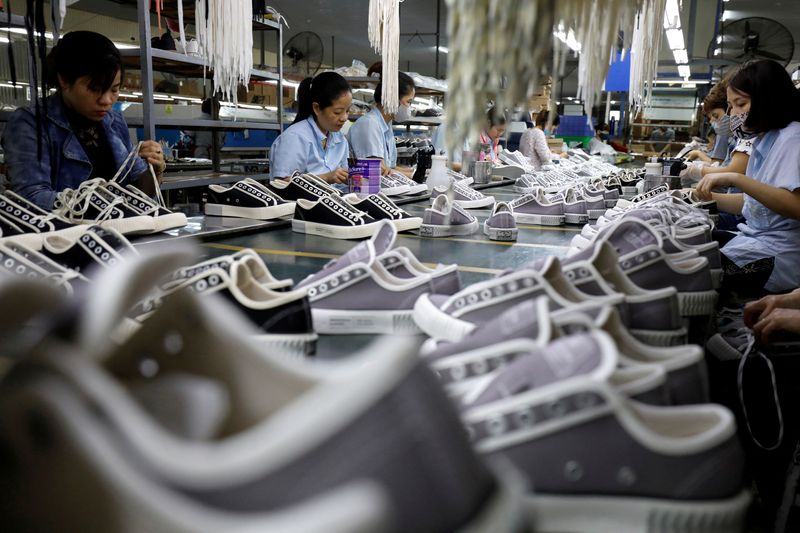By Francesco Guarascio
HANOI (Reuters) - As the United States intensifies efforts to reduce trade with China by hiking tariffs, it has greatly boosted imports from Vietnam, which relies on Chinese input for much of its exports, data show.
The surge in the China-Vietnam-U.S. trade has vastly widened trade imbalances, with the Southeast Asian country last year posting a surplus with Washington close to $105 billion - 2.5 times bigger than in 2018 when the Trump administration first put heavy tariffs on Chinese goods.
Vietnam now has the fourth-highest trade surplus with the United States, lower only than China, Mexico and the European Union.
The increasingly symbiotic relationship emerges from trade, customs and investment data reviewed by Reuters from the United Nations, the U.S., Vietnam and China, and is confirmed by preliminary estimates from the World Bank and half a dozen economists and supply chains experts.
It shows that Vietnam's export boom has been fuelled by imports from neighbouring China, with inflows from China almost exactly matching the value and swings of exports to the United States in recent years.
In preliminary estimates shared with Reuters, the World Bank reckons a 96% correlation between the two flows, up from 84% before Donald Trump's presidency.
"The surge in Chinese imports in Vietnam coinciding with the increase in Vietnamese exports to the U.S. may be seen by the U.S. as Chinese firms using Vietnam to skirt the additional tariffs imposed on their goods," said Darren Tay, lead economist at research firm BMI, noting that could lead to tariffs against Vietnam after U.S. elections.
The growing trade imbalance comes as Vietnam seeks to obtain market economy status in Washington after President Joe Biden pushed to elevate diplomatic ties with its former foe.
At over $114 billion last year, U.S. imports of goods from Vietnam were more than twice as big as in 2018 when the Sino-American trade war began, which boosted the Southeast Asian nation's appeal among manufacturers and traders who sought to reduce risks linked to China-U.S. tensions.
That surge accounted for more than half the $110-billion drop since 2018 in imports from Beijing, U.S. trade data show.
In key industries such as textiles and electric equipment, "Vietnam captured more than 60% of China's loss," said Nguyen Hung, a specialist in supply chains at RMIT University Vietnam.
But Chinese input remains crucial, as much of what Vietnam exports to Washington is made of parts and components produced in China, data show.
Imported components accounted in 2022 for about 80% of the value of Vietnam's export of electronics - the U.S.'s main import from Hanoi - according to data from the Asian Development Bank.
One-third of Vietnam's imports come from China, mostly electronics and components, according to Vietnam data which did not provide further detail.
Around 90% of intermediate goods imported by Vietnam's electronics and textile industries in 2020 were subsequently "embodied in exports", the Organisation for Economic Co-operation and Development said in a report, noting that was higher than a decade earlier and far above the average in industrialised countries.
The symbiotic relationship is reflected in latest data: In the first quarter of this year, U.S. imports from Vietnam amounted to $29 billion, while Vietnam's imports from China totalled $30.5 billion, mirroring similarly corresponding flows in past quarters and years.
As inflation remains high, the White House has remained quiet on Vietnam's large trade surplus, but that may change after the November vote, analysts say.
"A possible scenario is that after elections, whoever wins may change the policy towards Vietnam," said Nguyen Ba Hung, principal economist at ADB's Vietnam mission, noting that would however raise U.S. import costs.
The U.S. Embassy in Hanoi declined to comment on trade imbalances.
Vietnam's foreign and trade ministries did not reply to requests for comment.
China's commerce ministry did not immediately respond to a request for comment.
COTTON AND PANELS
The surge in the China-Vietnam-U.S. trade reflects the rise in investments in the Southeast Asian manufacturing hub, as companies relocate some activities from China.
Many of those manufacturers are Chinese firms that add value in their new factories in Northern Vietnam but still rely heavily on supply chains from their homeland.
But in some cases the trade involves finished products labelled as "Made in Vietnam" despite no value being added in the country, as the U.S. Department of Commerce concluded in an investigation over solar panels last year. A separate probe on aluminium cables and second on allegedly unfairly subsidised solar panels are underway.
Another reason Vietnam is drawing U.S. scrutiny is its exposure to Xinjiang, the Chinese region from where the U.S. bans imports over accusations of human rights violations against minority Uyghurs.
Xinjiang is China's main source of cotton and polysilicon used in solar panels. Both are key for Vietnam's industry, whose exports of cotton apparel and solar panels accounted for about 9% of exports to the U.S. last year.
Vietnam is the country with the highest volume of shipments by value denied entry into the U.S. over Uyghur forced labour risks, according to U.S. customs data.
Vietnam's import of raw cotton from China fell by 11% last year to 214,000 tons, but it was roughly twice as big as in 2018.

China also exported to Vietnam at least $1.5 billion-worth of cotton apparel, up from nearly $1.3 billion in 2022. Meanwhile, U.S. imports of cotton clothes from Vietnam fell by 25% to $5.3 billion last year, according to the data, which may not include all cotton items.
The fall in U.S. imports came as Vietnam last year surpassed China as the main exporter of products covered by the Xinjiang ban, said Hung Nguyen of RMIT.